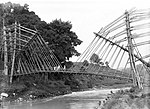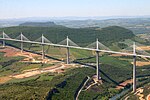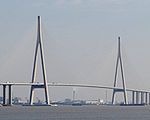Cable-stayed bridge
A cable-stayed bridge is a bridge whose girder is suspended from ropes stretched diagonally from a pylon .
Function of the structure
The vertical loads are transferred to the pylon or pylons via the tensioning cables in the form of tensile forces and are then introduced vertically into the subsoil in the form of compressive forces. The horizontal force components arise on both sides in the direction of the pylon and are neutralized by the pavement girder.
The anchoring of the horizontal force component of the suspension cable, which is required for a real suspension bridge, is not required. Cable- stayed bridges are therefore more cost-effective than suspension bridges, but so far only have spans about half the size (at the Russki Bridge and the Sutong Bridge a little over 1000 m). Girder bridges are often more economical up to a span of 200 m .
Like all suspension bridges, cable-stayed bridges are generally sensitive to wind forces and can be made to vibrate by large moving masses. However, they show better properties here than suspension bridges, which is why they z. B. are more suitable as railway bridges.
Bridge rope inspection devices are used to inspect the supporting structure .
variants
Single-hip, multi-hip bridges
| single-hip cable-stayed bridge, harp shape | double-hip cable-stayed bridge, tufted shape | |||||
|---|---|---|---|---|---|---|
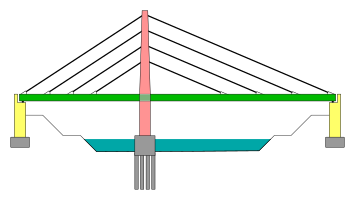 |
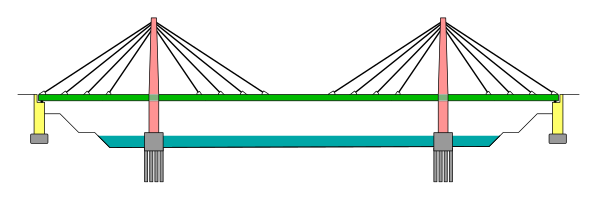
|
|||||
|
||||||
However, there are also bridges with three pylons, such as the Polcevera Viaduct in Genoa , bridges with four pylons such as the Rio-Andirrio Bridge near Patras in Greece, and the General Rafael Urdaneta Bridge over Lake Maracaibo with six pylons and the Viaduc de Millau in southern France, which with its seven pylons also has a top position in this regard. Multi-hipped bridges place special demands on the construction, as the moving load z. B. a truck has an impact on the support system of the neighboring pylon, which in turn can affect the next pylon.
Rope arrangement
The ropes can be arranged in a cluster, harp or fan system. With the bundle system, the cables are all anchored in a knot. The pylon is therefore only stressed by vertical normal forces. With the harp system, the ropes have the same tensile forces due to the same inclination, but the pylon usually also has to carry additional horizontal forces. The fan system is approximately a combination of the other two systems. At first only a few were used strong ropes, but soon the development went in the direction of multi-cable system with many smaller ropes, as there is a cantilever without much effort is possible and they can be easily replaced.
Symmetrical, asymmetrical and anchored bridges
Most cable-stayed bridges are symmetrical , their cable arrangement is the same on both sides of the pylon. Apart from wind and traffic loads, the pavement girders of the same length hang in balance on both sides of the pylon. In many bridges, however, the portion of the girder above the main opening is longer and therefore heavier than that above the side opening. With these asymmetrical bridges, the different weights have to be compensated, for example by making the shorter part of the girder heavier or stabilized by an abutment that serves as a tie rod or by supports that also serve as tie rods ( cf.Fleher Bridge ). Some bridges do not have a side opening, the stay cables only carry the girder above the main opening. With them, the pylons have to be anchored back in the ground with the help of anchor blocks (one example is the Carpineto Bridge ).
Pylon geometry
As a result of the rope anchoring, pylons are mainly subjected to vertical compressive forces. However, different forces in the ropes also cause bending moments.
With two rope levels, a distinction can be made between three basic pylon types. Cantilever towers are deformable in the transverse direction and make the bridge more sensitive to vibrations. In contrast, A-pylons are very stiff in the transverse direction, which means that the main bridge girder can be made lighter. The H-pylons are softer than the A-pylons, but their manufacture and the anchoring of the ropes at the pylon head is easier. The ropes are only inclined in one plane and the associated anchoring is distributed over two pylon posts.
A central pylon, usually a self-supporting tower, is arranged at a rope level. However, this type of construction requires a heavy main bridge girder which is torsionally rigid in the transverse direction .
Most of the pylons are vertical. In the case of back-anchored bridges, they are occasionally inclined away from the main opening towards the anchor blocks, as is the case with the Ponte all'Indiano , in rare cases also over the main opening, such as the Batman Bridge or the comparatively small Schenkendorf Bridge for a tram , pedestrians and cyclists.
While at the beginning pylons mostly consisted of steel, often multi-cell solid wall constructions with hollow cross-sections, today pylons of large cable-stayed bridges are almost exclusively made of reinforced concrete. In contrast, prefabricated, round pylon bars are used in all positions that distribute loads and tensile forces, especially for pedestrian bridges, so that inclined bars with irregular bracing are not uncommon.
Bridge deck
The bridge deck or the roadway girders , also called stretch girders in cable-stayed bridges , consist regularly of aerodynamically shaped, flat steel box girders with an orthotropic plate . However, there are also bridge decks made of prestressed concrete hollow box girders. The first and still greatest example of this is the General Rafael Urdaneta Bridge over Lake Maracaibo, designed by Riccardo Morandi . Occasionally there are also combinations of steel box girders in the main opening and concrete box girders in the side opening, as in the Fleher Bridge . Composite constructions, in which the steel absorbs the tensile forces and the concrete absorbs the compressive forces, theoretically represent an obvious solution, but have seldom remained.
history
precursor
It is no longer possible to determine when the first diagonally guyed bridges were built. From Africa reports of bridges with diagonally spanned lianas over the upper Ogooué have been reported, from Laos , Borneo and Java bamboo bridges with sometimes considerable spans are known.
In Europe, the suspension system of the cable-stayed bridge was probably first presented by Fausto Veranzio in his Machinae Novae , printed around 1616 . In 1784 Carl Immanuel Löscher published a detailed description of a wooden cable-stayed bridge, but it was probably not built. Charles Stewart Drewry reports on a 33.50 m long cable-stayed bridge that was built in 1817 by James Redpath and John Brown from Edinburgh in Peebles at King's Meadow over the Tweed . The Dryburgh Bridge , built in 1817 with inclined chains, was destroyed in a storm just a year later and thus interrupted further development in this direction.
Claude Navier published the first fundamental treatise on suspension bridges in 1823, in which he also mentioned cable-stayed bridges, without expressing great confidence in this type of construction.
The first bridge of this design in Germany was the Saale Bridge near Nienburg, built by Gottfried Bandhauer , the master builder of the Duchy of Anhalt-Köthen and inaugurated in August 1825 . It could be opened in the middle to allow ships with standing masts through, and therefore consisted of two independent halves. The only possible support elements were therefore inclined chains. At a festival in honor of the Duke on December 6, 1825, the bridge was subjected to extremely one-sided loads and collapsed due to vibrations caused by people dancing. In this accident, 55 people drowned in the hall .
John August Roebling built his bridges as a mixed system: the large suspension bridges were stiffened by inclined ropes, for example the Monongahela Bridge in Pittsburgh (1846), which was later replaced by the Smithfield Street Bridge , and the Niagara Falls Suspension Bridge (1854), the Cincinnati – Covington Bridge (1866) and finally the Brooklyn Bridge (1883).
Rowland Mason Ordish (1824-1886) had developed his own system, which he applied to the Franz Joseph Bridge (1868), an inclined chain bridge in Prague , and which he repeated with the Albert Bridge (1872) in London without much success.
Ferdinand Arnodin also developed a mixed system in his steel construction and wire rope company, in which stay ropes are initially tensioned from the pylons to the road girder and only a third to two quarters of the span is suspended from the suspension cables with hangers, as is the case with the Pont de l'Abîme (1887) or the Pont Sidi M'Cid (1912) in Constantine (Algeria) .
In the USA , Edwin Elijah Runyon received a patent for a cable-stayed bridge, on the basis of which two bridges were built in Texas in the 1890s .
In France at the end of the 19th century, Albert Gisclard developed a system of crossing stay cables that reached into the other half of the bridge. Numerous bridges were built according to this system, often by Ferdinand Arnodin's company, in which his son-in-law Gaston Leinekugel Le Cocq supervised the construction work and later further developed the Gisclard system. The most famous of Gisclard's bridges is the Pont de Cassagne railway bridge (1908); after his death, the Viaduc des Rochers Noirs (1913) and the Puente Colgante de Santa Fe (1924) were created in Argentina . Leinekugel Le Cocq continued Gisclard's ideas and converted the old suspension bridge Pont de Lézardrieux over the Trieux in Brittany into a cable-stayed bridge in 1925. The so-called suspension bridge of Deir ez-Zor may have been the last bridge of this type.
Modern cable-stayed bridges
Papers published by Franz Dischinger in 1949 laid the theoretical foundations for the construction of modern cable-stayed bridges. While earlier bridges were criticized because of their too slack stay cables, higher tensions and thus stiffer bridges were now possible with cables made of high-strength wires.
It is not known whether Albert Caquot was aware of these publications. In any case, as part of the construction of the Canal de Donzère-Mondragon, he built, among other things, the Donzère-Mondragon cable-stayed bridge with a bridge deck and reinforced concrete pylons. It was completed in 1952 together with the canal and was the first modern cable-stayed bridge. However, possibly because of its small size and remoteness, it had little influence on the further development of cable-stayed bridges.
In 1952, a group of engineers led by Fritz Leonhardt was commissioned to design the north bridge in Düsseldorf , which later became the Theodor Heuss Bridge . Leonhardt took up Dischinger's suggestions and designed a cable-stayed bridge with a span of 260 meters, a total length of 914 meters and a steel bridge deck. At the instigation of the architect Friedrich Tamms , head of the city planning office, he changed the initially intended arrangement of the ropes in the form of tufts into a harp shape with parallel ropes which, even when viewed from an angle, cannot optically overlap.
In the meantime, the Strömsundsbron in Sweden designed by Franz Dischinger and built by Demag in 1955 had been completed. It has a main span of 182 meters with a total length of 332 meters and also a steel box girder. It is commonly referred to as the world's first large cable-stayed bridge.
The Theodor Heuss Bridge was built later and was completed in 1957. It was the first cable-stayed bridge in Germany. Shortly thereafter, Tamms commissioned Fritz Leonhardt with the planning for the Rheinkniebrücke and Hans Grassl for the Oberkasseler Brücke . The three bridges were characterized by the same style elements - a flat steel bridge deck, slender vertical pylons and a few, harp-shaped stay cables - and thus became the Düsseldorf bridge family , even if the Rheinknie Bridge was not made until 1969 and the Oberkassel Bridge was provisional in 1973 and finally after its relocation were only opened to traffic in 1976. You have had a major impact on the development of cable-stayed bridges worldwide for many years.
The bridge type spread rapidly; Above all, the great need for reconstruction in Germany drove its development. At Expo 58 he became known to a wide audience thanks to the walkway to the pavilions designed by Egon Eiermann and Sep Ruf . In 1959, the Severinsbrücke was opened in Cologne with the first A-shaped pylon, which resulted in a particularly stiff bridge deck. In 1961, the Leonhardt & Andrä office on Schillersteg showed for the first time a sloping pylon that was anchored back to the ground. In 1962 the Norderelbbrücke was completed in Hamburg as the first pure motorway bridge. Between 1959 and 1962 the bridge designed by Riccardo Morandi was built over Lake Maracaibo in Venezuela, the first of a long series of cable-stayed bridges with pylons and bridge decks made of concrete. In 1964, the George Street Bridge in Newport , South Wales, was the first modern cable-stayed bridge in Great Britain and the following year with the largely overlooked Pont de Saint-Florent-le-Vieil, the first steel bridge in France. With the Leverkusen Rhine Bridge, Helmut Homberg built another motorway bridge similar to the Hamburg Norderelbe bridge with only two harp-shaped ropes on each side of the two central pylons.
With the Friedrich-Ebert-Brücke in Bonn and the Rees-Kalkar Rhine bridge, also completed in 1967 , both also designed by Homberg, cable-stayed bridges with a large number of ropes were created for the first time, which was only possible through the introduction of powerful IT systems .
Examples of further development
Improvements in the calculation methods and materials as well as the enormous increase in the performance of the EDP systems led to a diversification of the cable-stayed bridges in a wide variety of types and variants in a short time. For example, the Kurt Schumacher Bridge (1972) between Mannheim and Ludwigshafen has a high A-pylon with an asymmetrical arrangement of cables and, for the first time, cables made from parallel wire bundles. The Köhlbrand Bridge (1974) in the Port of Hamburg, with its A-pylons, the stems of which encompass the deck girder, was the model for a large number of similar pylons or those derived from it. The Raiffeisen bridge (1978) over the Rhine in Neuwied has an A-pylon in the longitudinal direction of the bridge, the airport bridge (2002) in the Ilverich crossing of the Rhine has pylons in the form of vertically positioned triangles because of the nearby Düsseldorf airport. The Fleher Bridge (1979) over the Rhine in Düsseldorf has the highest pylon and with 368 m the longest span of the cable-stayed bridges in Germany; It also combines a steel box girder in the main opening with a reinforced concrete box girder on the side of the pylon facing the land. The stay cables of the Obere Argen viaduct (1990) on the A96 near Wangen are continued under the carriageway girder as trusses with three air supports. The Storchenbrücke (1996) in Winterthur is the first bridge with stay cables made of carbon fiber reinforced plastic (CFRP) .
Inclined pylons
A number of bridges have inclined pylons, as the outer stay cables are not attached to the deck but anchored in the ground. Examples are the Viadotto Ansa del Tevere (1967) in Rome, the Batman Bridge (1968) in Tasmania, which is also the oldest cable-stayed bridge in Australia, the New Danube Bridge (1972) in Bratislava with a tower restaurant on the pylon, the Carpineto Bridge ( 1977) in southern Italy, the Ponte all'Indiano (1978) in Florence, the Rhine Bridge N4 (1995) near Schaffhausen and the Erasmus Bridge (1996) in Rotterdam.
A special feature is the Puente del Alamillo (1992) in Seville by Santiago Calatrava , in which the inclined pylon forms the counterweight to the bridge superstructure.
In other bridges, the inclined pylons are due to the curved roadway, such as the Abdoun Bridge (2006) in Amman, the only cable-stayed bridge in Jordan, or the Pont de Térénez (2011) in Brittany .
Concrete roadway girders
Examples of cable-stayed bridges with concrete carriageway girders are the bridge over the Wadi al-Kuf (1971), the West Works Bridge (Höchst) (1972) over the Main, the first cable-stayed bridge for road and rail traffic, the Puente General Manuel Belgrano (Puente Chaco –Corrientes) (1973) over the Río Paraná , the Puente Pumarejo (1974) in Barranquilla , Colombia, the Prince Willem Alexander Bridge (1974) over the Waal near Tiel in the Netherlands, the Brotonne Bridge (1977) over the Seine , the Danube Bridge Metten (1981) near Deggendorf, the Most Slobode or ( Liberty Bridge ) (1981) in Novi Sad , Serbia, the Sunshine Skyway Bridge (1987) over Tampa Bay in Florida, the Puente Ingeniero Carlos Fernández Casado (1983 ) over the Barrios de Luna reservoir in northern Spain with a span of 440 m and the Skarnsundbrua (1991) in Norway with the largest span of 530 m in this group at present (2013). The comparatively small Rhine bridge Diepoldsau (1985) over the Alpine Rhine shows that cable-stayed bridges are also possible with road girders made of a concrete slab only 55 cm thick. The asymmetrical Pont de Gilly has a continuous girder connected to the inclined pylon and was swiveled 90 ° over the river after it was built.
Carriageway girders made of steel and concrete composite
The first cable-stayed bridge with a girder made of a steel and concrete composite was the Second Hooghly Bridge (1972–1992) in Calcutta , followed by the two bridges that were completed earlier, the Ponte Edgar Cardoso (1982) in Figueira da Foz in Portugal and the Alex Fraser Bridge (1986) in Greater Vancouver, Canada. The Puente Río Mezcala (1993) in Mexico, the Second Severn Bridge (1996) near Bristol in England, the three-hip Ting Kau Bridge (1998) in Hong Kong and the Puente Orinoquia (2006) and the Puente Mercosur (probably 2016) across the Orinoco in Venezuela are other examples. The Berliner Brücke (2006) in Halle (Saale) was the first composite bridge in Germany. The Puente de la Constitución de 1812 (2015) over the Bay of Cadiz in Spain is one of the most recent examples.
Combined cable-stayed bridges
If the available space is not sufficient for a double-hip cable-stayed bridge or if it would be too expensive under the given circumstances, a single-hip cable-stayed bridge is occasionally combined with the cantilever girders of a cantilever bridge , as is the case with the factory bridge West (Höchst) (1972) or Franjo Tuđman Bridge (2002) near Dubrovnik.
Extradosed bridges
Some cable-stayed bridges are viewed as extradosed bridges , such as the cable-stayed bridge (1975) in Vienna and the Ganterbrücke (1980) as part of the Simplonpassstrasse and the Sunnibergbrücke (1998) near Klosters , both designed by Christian Menn , and also the Hochstraße Považská Bystrica (2010) with 7 pylons.
Multi-hip cable-stayed bridges
In multi-hip cable-stayed bridges, the effects of the moving loads on the neighboring pylons are limited by various measures. This can be seen, for example, in the General Rafael Urdaneta Bridge (1962) over Lake Maracaibo in Venezuela, the former Polcevera Viaduct (1967) in Genoa, the Ting Kau Bridge (1998), Hong Kong with four rope levels, the Puente Orinoquia (2006) over the Orinoco and at the Rio-Andirrio Bridge (2004) in Greece, with 4 pylons and a length of 2252 m and at the Viaduc de Millau (2004) in France, the one with 7 pylons and 2460 m longest cable-stayed bridge in the world.
The three-hip Queensferry Crossing (2017) has for the first time again crossed stay cables for more even load distribution.
Largest cable-stayed bridges
The cable-stayed bridges with the largest spans of their time
| Surname | Span in m |
carrier | Period |
|---|---|---|---|
| Theodor Heuss Bridge , Düsseldorf | 260 | steel |
1957–1959
|
| Severinsbrücke | 302 | steel |
1959–1969
|
| Rheinkniebrücke | 319 | steel |
1969–1971
|
| Neuenkamp bridge over the Rhine | 350 | steel |
1971–1975
|
| Saint Nazaire Bridge | 404 | steel |
1975–1983
|
| Puente Ingeniero Carlos Fernández Casado | 440 | concrete |
1983–1986
|
| Alex Fraser Bridge | 465 | Composite |
1986–1991
|
| Skarnsundbrua | 530 | concrete |
1991–1993
|
| Yangpu Bridge | 602 | Composite |
1993–1995
|
| Pont de Normandie | 856 | steel |
1995–1999
|
| Tatara Bridge | 890 | steel |
1999–2008
|
| Sutong Bridge | 1088 | steel |
2008–2012
|
| Russky Bridge | 1104 | steel |
seit 2012
|
Other records
The Oresund Bridge (2000) between Denmark and Sweden is the longest cable-stayed bridge for combined road and rail traffic. The widest is the Leonard P. Zakim Bunker Hill Memorial Bridge (2002) in Boston, USA, with ten lanes and 56 m wide. The Suez Canal Bridge (2001) with a clearance of 70 m is the highest cable-stayed bridge in the world built in flat land, and the Baluarte Bridge (2012) in Mexico is the highest cable-stayed bridge in the world with a height of 402.5 m above the valley floor.
Further examples
Sutong Bridge over the Yangtze River
Christopher S. Bond Bridge over the Missouri
literature
- René Walther, Bernard Houriet, Walmar Isler, Pierre Moïa: Cable- stayed bridges . Revised edition and translation, Verlag Bau + Technik / Beton-Verlag, Düsseldorf 1994, ISBN 3-7640-0328-6 .
- Holger Svensson : Cable-stayed bridges, 40 years of experience worldwide 2011 Wilhelm Ernst & Sohn, Berlin ISBN 978-3-433-02977-0
- Karl-Eugen Kurrer , Eberhard Pelke , Klaus Stiglat : Unity of Science and Art in Bridge Building ': Hellmut Homberg (1909-1990) - The Work (Part III). In: Bautechnik 87 (2010), no. 2, pp. 86–115.
- Eberhard Pelke, Karl-Eugen Kurrer: The Development of Multi-Cable-Stayed Bridges . In: Nuts & Bolts of Construction History. Culture, Technology and Society , Vol. 3. Edited by R. Carvais, A. Guillerme, V. Nègre, J. Sakarovitch, pp. 657-665. Paris: Editions A. et J. Picard 2012.
See also
Individual evidence
- ↑ Gerhard Girmscheid: cable-stayed bridges . In: Gerhard Mehlhorn (Ed.): Handbook bridges. Design, construct, calculate, build and maintain. Springer, Berlin et al. 2007, ISBN 978-3-540-29659-1 , pp. 347-388.
- ↑ Leonardo Fernández Troyano: Tierra sobre el Agua. Vision Histórica Universal de los Puentes. Colegio de Ingenieros de Caminos, Canales y Puentes, Madrid 1999, ISBN 84-380-0148-3 , p. 661
- ↑ Carl Immanuel Löscher: Specification of a very special suspension bridge: which can be stretched very far across a river with few and weak wood, without being closed in an arch, carries the greatest loads and is safe from the strongest ice rides . Siegfried Lebrecht Crusius, Leipzig 1784
- ^ Charles Stewart Drewry: A Memoir on Suspension Bridges, Comprising the History of Their Origin and Progress,… . Longman, Rees, Orme, Brown, Green, & Longman, London 1832, p. 24
- ^ Robert Stevenson: Description of Bridges of Suspension . In The Edinburgh Philosophical Journal , edited by Sir David Brewster, Robert Jameson. Volume 5, No. 10, Edinburgh 1821. p. 237
- ^ Claude Navier: Report to Monsieur Becquey, conseiller d'état, directeur général des ponts et chaussées et des mines; et mémoire on the ponts suspendus . Imprimerie Royale, Paris 1823, p. 8f
- ↑ The collapse of the Nienburg inclined chain bridge on bernd-nebel.de
- ^ Michel Wagner: Les Ponts Gisclard, precurseurs des grands ponts à haubans.
- ^ Franz Dischinger: Suspension bridges for the heaviest traffic loads. In: civil engineer. Springer Verlag, Düsseldorf; (I): March 1949, No. 3, pp. 65-75; (II): April 1949, No. 4, pp. 107-113.
- ^ A b Fritz Leonhardt: Master builder in a revolutionary time. Memories. 2nd ed. Dt. Verl.-Anst., Stuttgart 1998, ISBN 3-421-02815-X .
- ^ Senior City Director of the State Capital Düsseldorf (Ed.): Bridges for Düsseldorf 1961–62. Springer, Berlin approx. 1963.
- ^ Holger Svensson: Cable-stayed bridges. 40 years of experience worldwide. Ernst & Sohn, Weinheim 2011, p. 60.
- ^ Gerhard Mehlhorn (Ed.): Handbook bridges. 2nd edition, Springer-Verlag, Berlin Heidelberg 2010, ISBN 978-3-642-04422-9 , p. 92.





